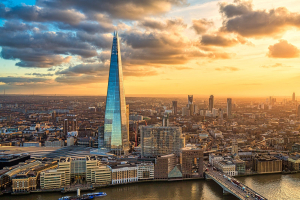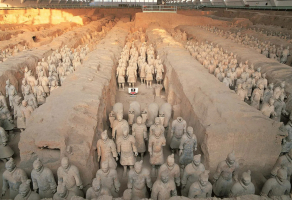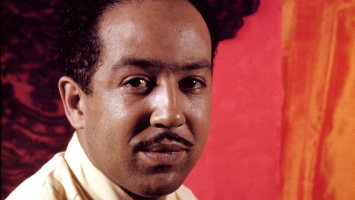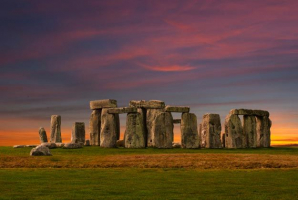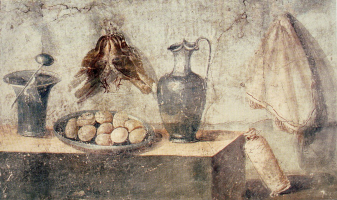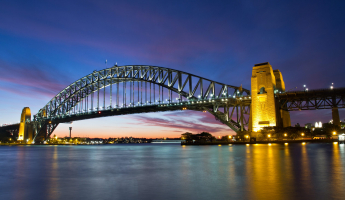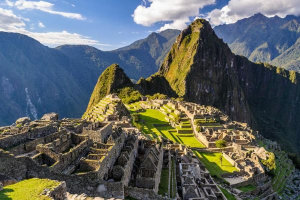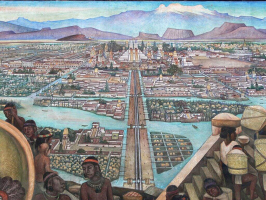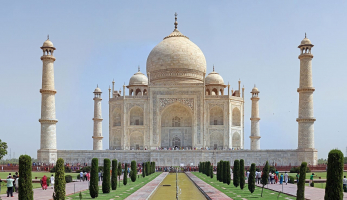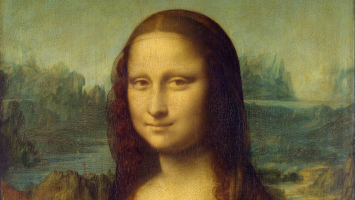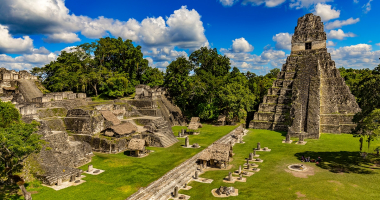Top 7 Most Famous Wonders of the Ancient World
The Seven Wonders of the Ancient World (also known as the World's Seven Wonders or simply the Seven Wonders) is a list of seven notable structures that existed ... read more...during classical antiquity. The first known list of seven wonders dates from the second to first centuries BC. The Great Pyramid of Giza, the Colossus of Rhodes, the Lighthouse of Alexandria, the Mausoleum at Halicarnassus, the Temple of Artemis, the Statue of Zeus at Olympia, and the Hanging Gardens of Babylon are the seven traditional wonders. Only the Pyramid of Giza, by far the oldest of the seven wonders, remains standing, with the others having been destroyed over the centuries. Find out with Toplist the 7 most famous Wonders of the Ancient World.
-
One of the most famous Wonders of the Ancient World is the Great Pyramid of Giza. The Great Pyramid of Giza is the largest Egyptian pyramid and the tomb of Pharaoh Khufu of the Fourth Dynasty. The pyramid, which was built during a 27-year period in the early 26th century BC, is the oldest of the Seven Wonders of the Ancient World and the only one that has survived largely intact. It borders present-day Giza in Greater Cairo, Egypt, as part of the Giza pyramid complex.
For more than 3,800 years, the Great Pyramid stood at 146.6 meters (481 feet) and was the tallest man-made monument in the world. Most of the smooth white limestone casing was removed over time, reducing the pyramid's height to the current 138.5 meters (454.4 ft). The base was measured to be about 230.3 meters (755.6 ft) square, with a volume of about 2.6 million cubic meters (92 million cubic feet) when an internal hillock was included.
The Great Pyramid of Giza was constructed by quarrying an estimated 2.3 million large blocks weighing a total of 6 million tonnes. The majority of the stones are not uniform in size or shape, and they are only loosely prepared. Mortar was used to hold the outer layers together. Local limestone from the Giza Plateau was primarily utilized. Other pieces were brought down the Nile by boat: white limestone from Tura for the casing and granite blocks weighing up to 80 tonnes from Aswan for the King's Chamber structure.
Inside the Great Pyramid, there are three known chambers. The lowest was a cut into the bedrock upon which the pyramid was built, but it was never completed. The Queen's Chamber and King's Chamber, both of which contain a granite sarcophagus, are located higher up in the pyramid structure. The funerary complex surrounding the pyramid included two mortuary temples linked by a causeway (one near the pyramid and one near the Nile), tombs for Khufu's immediate family and court, three smaller pyramids for Khufu's wives, an even smaller "satellite pyramid," and five buried solar barges.
Location: Greater Cairo, EgyptBuilt: in the early 26th century BC
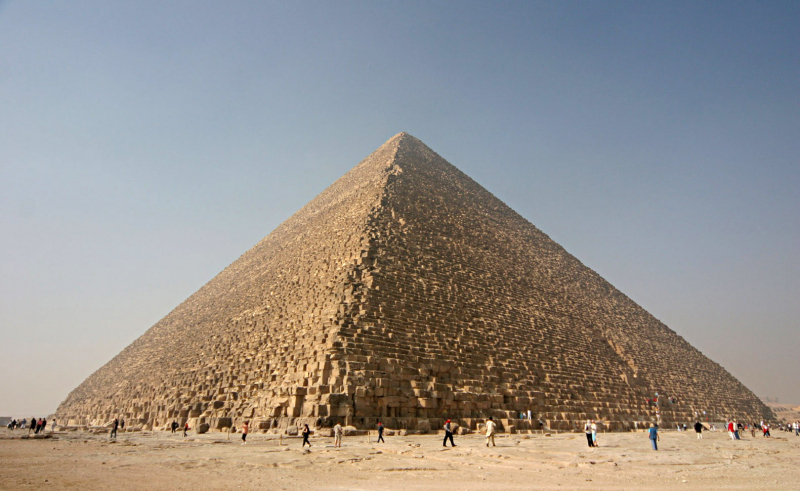
en.wikipedia.org BBC -
The Hanging Gardens of Babylon were one of Hellenic culture's Seven Wonders of the Ancient World. They were regarded as a stunning engineering marvel, with a rising succession of tiered gardens featuring a broad variety of trees, shrubs, and vines, like a vast green mountain made of mud bricks. It was supposed to have been built near present-day Hillah, Babil province, Iraq, in the ancient metropolis of Babylon.
According to mythology, the Neo-Babylonian King Nebuchadnezzar II (who ruled between 605 and 562 BC) created the Hanging Gardens alongside the enormous palace known as The Marvel of Mankind for his Median bride, Queen Amytis, who missed the verdant hills and valleys of her homeland. This was confirmed by the Babylonian priest Berossus, who wrote circa 290 BC and whose description was later cited by Josephus. The Hanging Gardens were also built by the fabled queen Semiramis, and they were known as the Hanging Gardens of Semiramis as an alternative name.
The Hanging Gardens are the only one of the Seven Wonders whose location has yet to be determined. No extant Babylonian texts mention the gardens, and no clear archaeological evidence has been discovered in Babylon. Three theories have been proposed to explain this: first, that they were purely mythical, and the descriptions found in ancient Greek and Roman writings (including those of Strabo, Diodorus Siculus, and Quintus Curtius Rufus) represented a romantic ideal of an eastern garden; second, that they existed in Babylon but were destroyed sometime around the first century AD; and third, that the legend refers to a well-documented garden that Assyrian King Sennach built in his capital city of Nineveh on the River Tigris, near the modern city of Mosul.
Location: near present-day Hillah, Babil province, in Iraq
Built: in the sixth century B.C
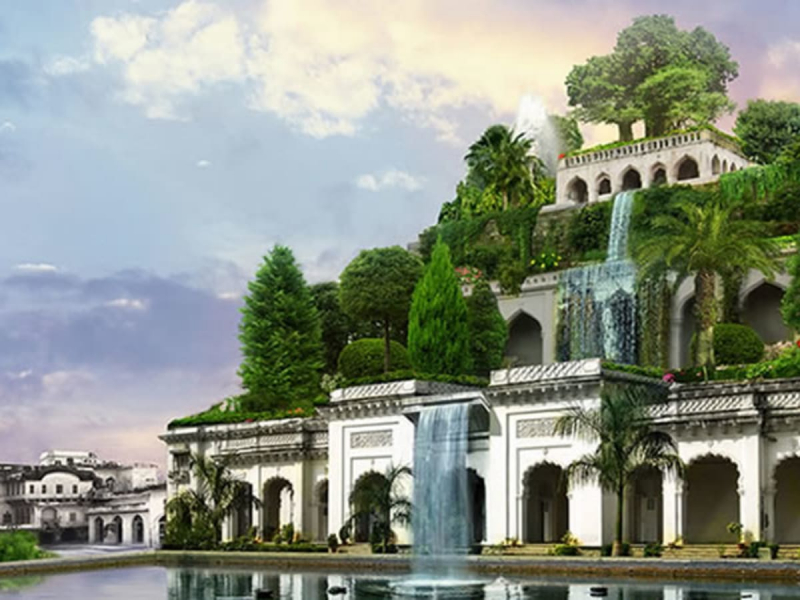
history.com See U in History / Mythology -
One of the most famous Wonders of the Ancient World is the Statue of Zeus. The statue at Olympia was a 12.4 m (41 ft) tall seated figure created by the Greek sculptor Phidias in approximately 435 BC at the sanctuary of Olympia, Greece, and erected in the Temple of Zeus there. In Greek mythology, Zeus is the sky and thunder god who reigns as King of the Gods of Mount Olympus. The sculpture was a chryselephantine sculpture made of ivory plates and gold panels mounted on a timber structure. Zeus sat on an ebony, ivory, gold, and precious stone-encrusted painted cedarwood throne. It was one of the Ancient World's Seven Wonders. The statue was lost and destroyed in the fifth century AD; only ancient Greek descriptions and coin depictions of its appearance survive.
The Eleans, custodians of the Olympic Games, commissioned the Zeus statue in the latter half of the fifth century BC for their newly completed Temple of Zeus. The Eleans hired artist Phidias, who had previously created the enormous statue of Athena Parthenos atop the Parthenon, in order to outdo their Athenian competitors.
The statue took up half the aisle of the temple that was designed to hold it. The Zeus was a chryselephantine sculpture with ivory and gold panels on a wooden substructure. There is no copy in marble or bronze, while there are recognizable but only approximate counterparts on coins from nearby Elis, as well as Roman coins and engraved jewels.
The statue was adorned with a sculpted wreath of olive sprays and wore a gilded robe made of glass and engraved with animals and flowers, according to the 2nd-century AD geographer and traveler Pausanias. It held a tiny chryselephantine statue of crowned Nike, goddess of triumph, in its right hand, and a scepter inlaid with several metals, supporting an eagle in its left. The throne was adorned with gold, precious stones, ebony, and ivory and had painted figures and wrought pictures. Zeus' golden sandals rested on a footstool adorned in relief with an Amazonomachy. Painted screens blocked the entrance beneath the throne. The statue was destroyed along with the temple when it was destroyed by fire in 425 AD.
Location: The Temple of Zeus at Olympia, Greece
Built: 435 BC
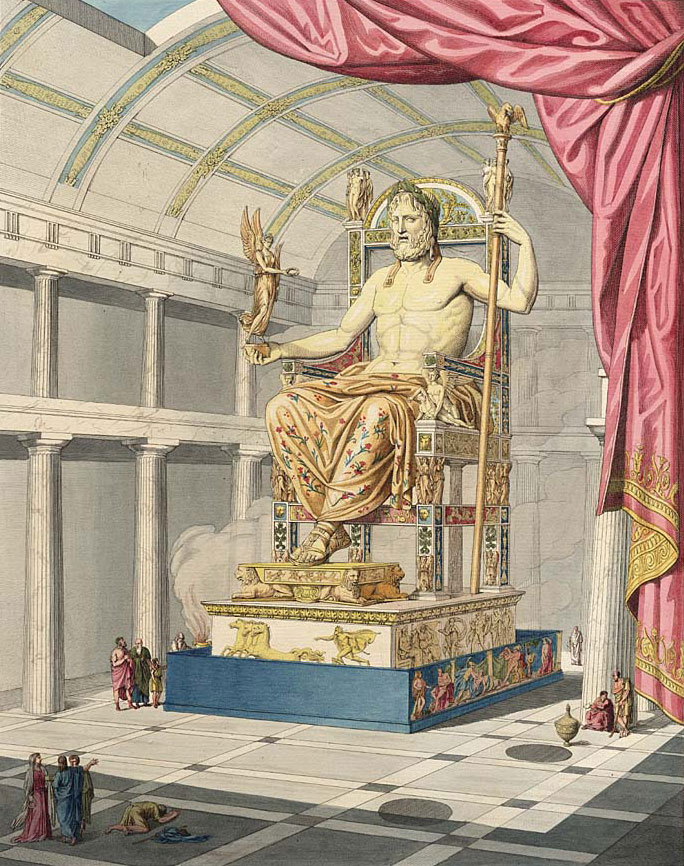
commons.wikimedia.org See U in History / Mythology -
The Temple of Artemis, also known as the Temple of Diana, was a Greek temple devoted to an ancient, localized version of the goddess Artemis (identified with Diana, a Roman goddess). It was located in Ephesus (near the contemporary Turkish town of Selçuk). It had been wrecked or destroyed by 401 AD. At the site, just the foundations and remains of the final temple remain.
The earliest temple (a Bronze Age temenos) predated the Ionic migration by many years. Callimachus gave it to the Amazons in his Hymn to Artemis. A flood destroyed it in the 7th century BC. A flood destroyed it in the 7th century BC. Its grander renovation began approximately 550 BC, under the Cretan architect Chersiphron and his son Metagenes. Croesus of Lydia funded the project, which took ten years to complete. Herostratus burned down this variant of the temple in 356 BC in an arson attack.
According to Pliny, the temple measured 115 meters long and 55 meters wide. He claimed it was almost entirely constructed of marble. It was around three times the size of the Parthenon in terms of area. There are 127 Ionic-style columns in the Temple. Each is 17.5 meters tall. Many beautiful artworks might be found in the Temple of Artemis. The temple housed bronze statues by famed Greek sculptors Polyclitus, Pheidias, Cresilas, and Phradmon. It also contained paintings and gold and silver gilded columns. Sculptors frequently competed to create the best sculpture. Many of these sculptures were of Amazons, who are thought to have established Ephesus.
The Temple of Artemis was a prosperous region. It served as a religious institution. It drew merchants and travelers from all around Asia Minor. Many beliefs impacted the temple. Many diverse peoples regard it as a symbol of faith. Cybele was worshiped by the Ephesians. Many of their beliefs were incorporated into the cult of Artemis. Cybele of Artemis grew extremely different from Diana of Rome. The Artemis cult drew thousands of followers from far-flung nations. They all gathered at the location to worship her.
Location: near the ancient city of Ephesus, Turkey
Built: the 6th century BCE
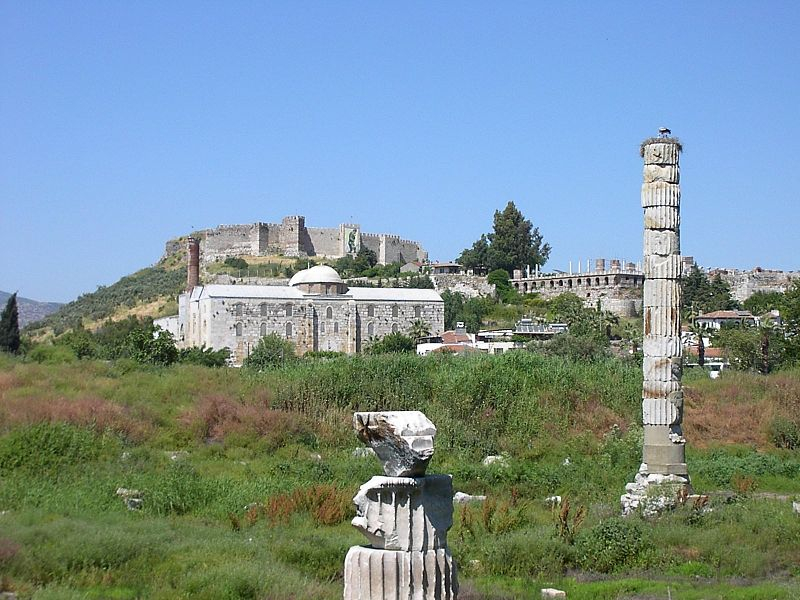
commons.wikimedia.org See U in History / Mythology -
The Mausoleum at Halicarnassus, also known as the Monument of Mausolus, was a tomb built between 353 and 350 BC in Halicarnassus for Mausolus, a native Anatolian from Caria and a satrap in the Achaemenid Empire, and his sister-wife Artemisia II of Caria. Satyros and Pythius of Priene, Greek architects, designed the edifice. Its elevated tomb structure is modeled after tombs in neighboring Lycia, which Mausolus attacked and occupied in 360 BC, such as the Nereid Monument.
The mausoleum was built on a hill with a view of the city. The entire edifice was encased in a courtyard. The tomb was located in the courtyard's center, on a stone platform. A ladder flanked by stone lions ascended to the top of the platform, which had several statues of gods and goddesses along its outside walls. Stone warriors on horseback guarded the tomb at each corner. The marble tomb rose as a square tapering block to one-third of the Mausoleum's 45 m (148 ft) height in the center of the platform. This area was covered with bas-reliefs depicting action events, such as the conflict of the centaurs with the Lapiths and the Greeks in battle with the Amazons, a race of warrior women.
Thirty-six slender columns, ten per side, with each corner sharing one column between two sides, rose for another third of the tomb's height. A statue stood between each pair of columns. Behind the columns was a strong cella-like block that supported the weight of the huge roof of the tomb. The pyramidal roof took up the majority of the final third of the height. On top was a quadriga, which consisted of four enormous horses hauling a chariot drawn by figures of Mausolus and Artemisia.
The Mausoleum was ornamented on all four sides with sculptural reliefs made by one of four Greek sculptors: Leochares, Bryaxis, Scopas of Paros, and Timotheus. The mausoleum was regarded as such an aesthetic accomplishment by Antipater of Sidon that he named it one of the Seven Wonders of the Ancient World. It was the latest of the six ruined marvels to be destroyed by successive earthquakes from the 12th to the 15th centuries.
Location: Halicarnassus (present Bodrum, Turkey)
Built: between 353 and 350 BC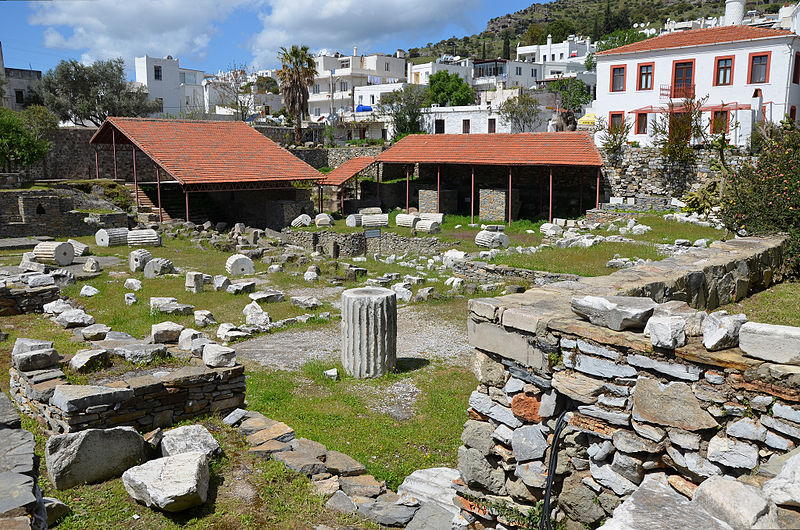
The ruins of the Mausoleum at Halicarnassus -en.wikipedia.org See U in History / Mythology -
One of the most famous Wonders of the Ancient World is The Colossus of Rhodes. It was a statue of the Greek sun-god Helios constructed in 280 BC by Chares of Lindos in the city of Rhodes on the Greek island of the same name. It was built to commemorate the successful defense of Rhodes city against an attack by Demetrius Poliorcetes, who had besieged it for a year with a great army and navy. It was one of the Seven Wonders of the Ancient World.
The Colossus was the tallest statue in the ancient world, standing around 70 cubits, or 33 meters (108 feet) tall - roughly the height of the present Statue of Liberty from feet to crown. It was destroyed in the earthquake of 226 BC, but sections of it were preserved. The Rhodians did not rebuild it in line with an oracle. John Malalas claimed that Hadrian re-erected the Colossus during his reign, but he was wrong. The Suda referred to the Rhodians as Colossaeans because they placed the monument on the island.
According to the Chronicle of Theophanes the Confessor, the monument was totally demolished and the remains were sold in 653 when an Arab force led by Muslim general Muawiyah I seized Rhodes. Since 2008, a number of unrealized ideas to build a new Colossus at Rhodes Harbour have been announced, while the exact position of the original monument is still unknown.
Location: Rhodes in the Dodecanese, Greece
Built: 280 BC
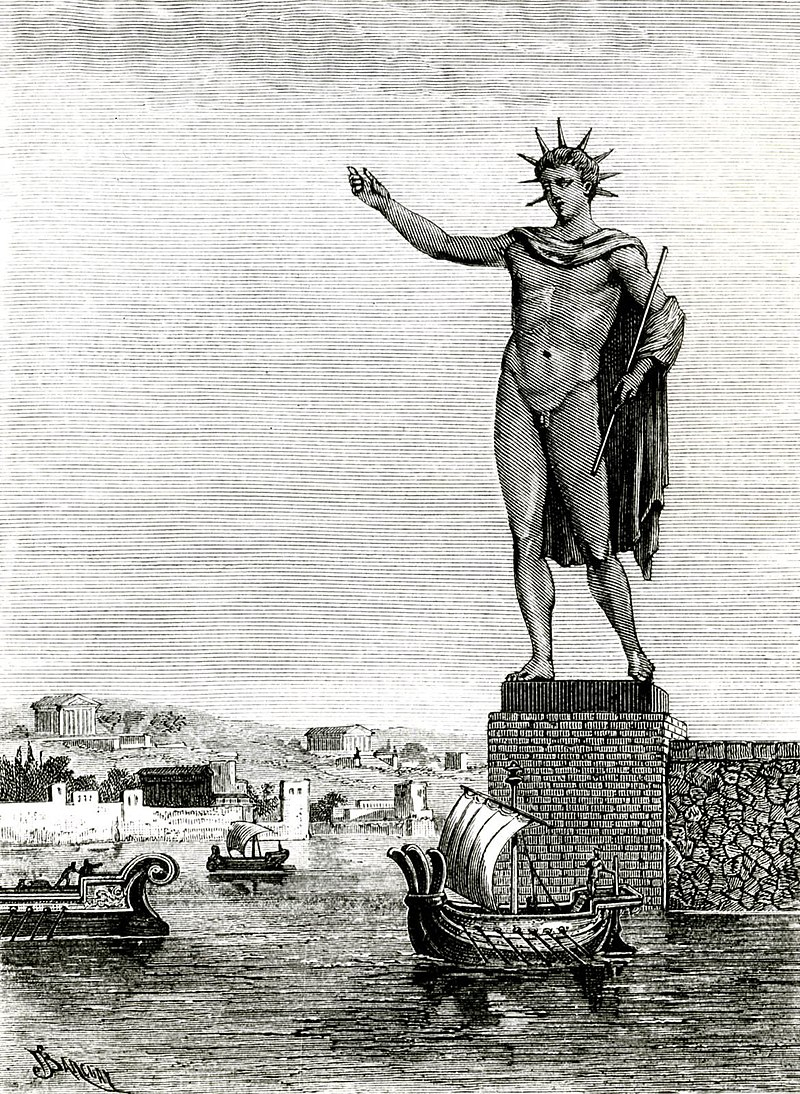
en.wikipedia.org TREY the Explainer -
The Lighthouse of Alexandria, also known as the Pharos of Alexandria, was a lighthouse built by the Ptolemaic Kingdom of Ancient Egypt during Ptolemy II Philadelphus' reign (280–247 BC). It is thought to have stood at least 100 meters (330 feet) tall. It was one of the Seven Wonders of the Ancient World and one of the world's highest man-made constructions for many centuries.
Between 956 and 1323 AD, three earthquakes severely damaged the lighthouse, which became an abandoned ruin. It was the third-longest remaining ancient wonder (after the Mausoleum of Halicarnassus and the still-standing Great Pyramid of Giza), lasting in part until 1480 when the last of its leftover stones were taken to construct the Citadel of Qaitbay on the site.
A team of French archaeologists descended into the water of Alexandria's Eastern Harbour in 1994 and uncovered the lighthouse's ruins on the sea floor. Egypt's Ministry of State for Antiquities announced plans in 2016 to turn submerged remnants of ancient Alexandria, notably the Pharos, into an underwater museum. The lighthouse was built during the third century BC. Following the death of Alexander the Great, the first Ptolemy (Ptolemy I Soter) declared himself king in 305 BC and commissioned its construction. The structure took twelve years to complete and cost 800 talents of silver during the reign of his son, Ptolemy II Philadelphus. The light was generated by a furnace at the top, and the tower was claimed to be constructed primarily of solid pieces of limestone and granite.
Earthquakes in 796 and 951 partially shattered and damaged the lighthouse, followed by a structural collapse in the earthquake of 956, and then again in 1303 and 1323. Earthquakes spread from two well-known tectonic limits, the African-Arabian and the Red Sea Rift zones, which are 350 and 520 kilometers from the lighthouse, respectively. According to the documentation, the 956 earthquakes were the first to cause a structural collapse of the top 20+ meters of the structure. Following the earthquake in 956, documented repairs included the installation of an Islamic-style dome following the destruction of the statue that formerly topped the monument. The most devastating earthquake in 1303 had an estimated magnitude of VIII+ and originated on the Greek island of Crete (280–350 km from Alexandria).
Location: on the island of Pharos in Alexandria, Egypt
Built: between 285 and 247 BCE
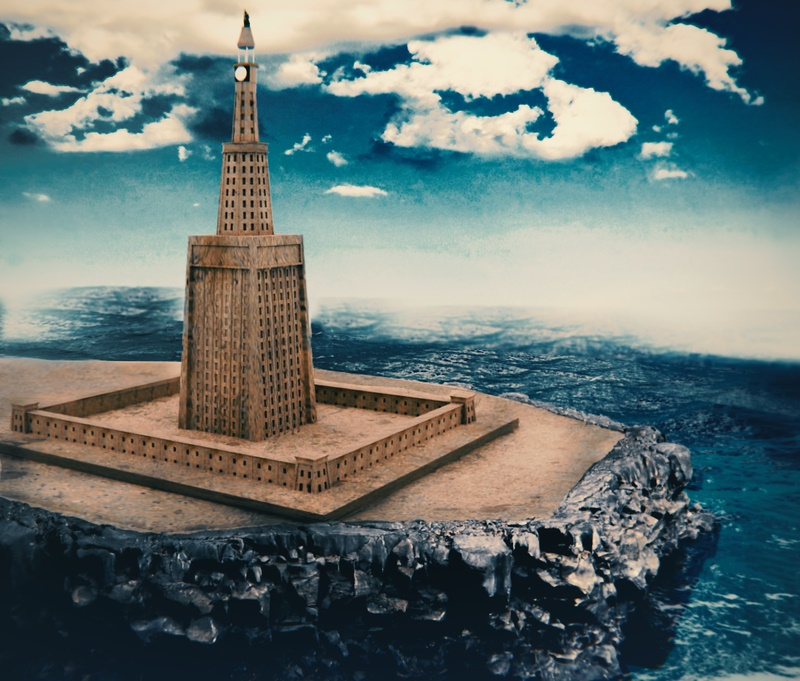
3D reconstruction of the Lighthouse of Alexandria -en.wikipedia.org See U in History / Mythology









